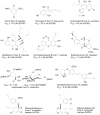Biodiversity conservation and drug discovery: Can they be combined? The Suriname and Madagascar experiences
- PMID: 20161050
- PMCID: PMC2746688
- DOI: 10.1080/13880200902988629
Biodiversity conservation and drug discovery: Can they be combined? The Suriname and Madagascar experiences
Abstract
The approach to new drugs through natural products has proved to be the single most successful strategy for the discovery of new drugs, but in recent years its use has been deemphasized by many pharmaceutical companies in favor of approaches based on combinatorial chemistry and genomics, among others.Drug discovery from natural sources requires continued access to plant, marine, and microbial biomass, and so the preservation of tropical rainforests is an important part of our drug discovery program. Sadly, many of the tropical forests of the world are under severe environmental pressure, and deforestation is a serious problem in most tropical countries. One way to combat this loss is to demonstrate their value as potential sources of new pharmaceutical or agrochemical products.As part of an effort to integrate biodiversity conservation and drug discovery with economic development, we initiated an International Cooperative biodiversity Group (ICBG) to discover potential pharmaceuticals from the plant biodiversity of Suriname and Madagascar. The Group, established with funding from agencies of the United States government, involved participants from the USA, Suriname, and Madagascar. The basic approach was to search for bioactive plants in the Suriname and Malagasy flora, and to isolate their bioactive constituents by the best available methods, but the work included capacity building as well as research. Progress on this project will be reported, drawing on results obtained from the isolation of bioactive natural products from Suriname and Madagascar. The benefits of this general approach to biodiversity and drug discovery will also be discussed.
Figures












Similar articles
-
Modern natural products drug discovery and its relevance to biodiversity conservation.J Nat Prod. 2011 Mar 25;74(3):496-511. doi: 10.1021/np100550t. Epub 2010 Dec 7. J Nat Prod. 2011. PMID: 21138324 Free PMC article. Review.
-
Bioactive labdane diterpenoids from Renealmia alpinia collected in the Suriname rainforest.J Nat Prod. 1997 Dec;60(12):1287-93. doi: 10.1021/np970233c. J Nat Prod. 1997. PMID: 9428162
-
The UIC ICBG (University of Illinois at Chicago International Cooperative Biodiversity Group) Memorandum of Agreement: a model of benefit-sharing arrangement in natural products drug discovery and development.J Nat Prod. 2004 Feb;67(2):294-9. doi: 10.1021/np0304363. J Nat Prod. 2004. PMID: 14987071 Review.
-
Novel Bioactive Natural Products Isolated from Madagascar Plants and Marine Organisms (2009-2017).Chem Pharm Bull (Tokyo). 2018;66(5):469-482. doi: 10.1248/cpb.c17-00395. Chem Pharm Bull (Tokyo). 2018. PMID: 29710044 Review.
-
Diversity and distribution of Orchidaceae in one of the world's most threatened plant hotspots (Madagascar).Biodivers Data J. 2023 Sep 19;11:e106223. doi: 10.3897/BDJ.11.e106223. eCollection 2023. Biodivers Data J. 2023. PMID: 38318515 Free PMC article.
Cited by
-
Cardenolides of Leptadenia madagascariensis from the Madagascar dry forest.Bioorg Med Chem. 2011 Jan 1;19(1):422-8. doi: 10.1016/j.bmc.2010.11.021. Epub 2010 Nov 11. Bioorg Med Chem. 2011. PMID: 21159516 Free PMC article.
-
Bioactive compounds from Stuhlmannia moavi from the Madagascar dry forest.Bioorg Med Chem. 2013 Dec 15;21(24):7591-4. doi: 10.1016/j.bmc.2013.10.038. Epub 2013 Nov 1. Bioorg Med Chem. 2013. PMID: 24239390 Free PMC article.
-
Antiproliferative compounds of Cyphostemma greveana from a Madagascar dry forest.Chem Biodivers. 2011 Apr;8(4):643-50. doi: 10.1002/cbdv.201000061. Chem Biodivers. 2011. PMID: 21480509 Free PMC article.
-
Harnessing biodiversity: the Malagasy Institute of Applied Research (IMRA).BMC Int Health Hum Rights. 2010 Dec 13;10 Suppl 1(Suppl 1):S9. doi: 10.1186/1472-698X-10-S1-S9. BMC Int Health Hum Rights. 2010. PMID: 21144080 Free PMC article.
-
A new species of Pandanaceae from northern Madagascar, Pandanus ankaranensis.Novon (St Louis). 2010 Sep 1;20(3):243-247. doi: 10.3417/2009105. Novon (St Louis). 2010. PMID: 21698065 Free PMC article.
References
-
- Abdel-Kader M, Berger JM, Slebodnick C, Hoch J, Malone S, Wisse JH, Werkhoven MCM, Neddermann KM, Mamber S, Kingston DGI. Isolation and absolute configuration of ent-halimane diterpenoids from Hymenaea courbaril from the Suriname rain forest. J Nat Prod 65. 2002:11–15. - PubMed
-
- Abdel-Kader M, Hoch J, Berger JM, Evans R, Miller JS, Wisse JH, Mamber SW, Dalton JM, Kingston DGI. Two bioactive saponins from Albizia subdimidiata from the Suriname rainforest. J Nat Prod. 2001;64:536–539. - PubMed
-
- Abdel-Kader MS, Bahler BD, Malone S, Werkhoven MCM, van Troon F, David M, Wisse JH, Burkuser I, Neddermann KM, Mamber SW, Kingston DGI. DNA-damaging steroidal alkaloids from Eclipta alba from the Suriname rain forest. J Nat Prod. 1998;61:1202–1208. - PubMed
-
- Abdel-Kader MS, Bahler BD, Malone S, Werkhoven MCM, Wisse JH, Neddermann KM, Bursuker I, Kingston DGI. Bioactive saponins from Swartzia schomburgkii from the Suriname rainforest. J Nat Prod. 2000;63:1461–1464. - PubMed
-
- Abdel-Kader MS, Wisse J, Evans R, van der Werff H, Kingston DGI. Bioactive iridoids and a new lignan from Allamanda cathartica and Himatanthus fallax from the Suriname rain forest. J Nat Prod. 1997;60:1294–1297. - PubMed
Grants and funding
LinkOut - more resources
Full Text Sources
